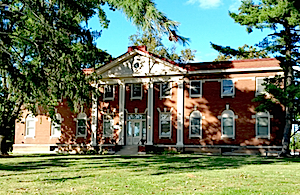
A task force appointed in January by Illinois Gov. Bruce Rauner is recommending that the state spend up to $245 million, including constructing a new residential building, to help protect residents and staff of the Illinois Veterans Home at Quincy from future cases of Legionnaires’ disease.
“Although all proposed options in this report are continued steps to Legionella remediation, anything less than complete reconstruction will fall short of providing a proposal with the full confidence and support of the Veterans’ Capital Needs Task Force,” the group said in a report issued late Tuesday.
The veterans home, which offers independent living and skilled nursing care for approximately 600 veterans, including some who have dementia, has been the setting of multiple Legionnaires’ disease outbreaks that have led to 13 resident deaths, dozens of illnesses and 11 lawsuits against the state in recent years, according to state and federal health officials and media accounts.
Water sources frequently are associated with the bacteria, but the home until recently had seen new cases of the disease even after implementing a comprehensive water management plan, building a new water treatment facility and taking other steps to reduce the risk of exposure. Water tests showed zero presence of Legionella after 750 new water faucet filters recently were installed, however, the state said in March.
The state already has issued a request for proposal for a master planning contract to explore building a new facility on the existing campus of the veterans home. The government also plans to buy and renovate a nearby nursing home and is considering using modular units as temporary housing for residents, Rauner said in March. The task force report said that the use of modular units is under review and would cost $18 million to $30 million, but the group currently does not recommend them.
In addition to constructing a new skilled nursing building for up to 300 residents, which the task force estimates would cost $190 million to $230 million, including demolition of the existing building, the body also “strongly recommends” completely replacing the underground water distribution system from the current water treatment facility to all existing and proposed buildings, at a cost of $2.2 million, as well as installing new piping at a cost of $13.4 million.
Additionally, the task force “strongly recommends” that an alternate source of water be developed for the home, at a cost of $3 million to $4.5 million, and backs the state’s plan to purchase and renovate an off-site facility to provide temporary housing for up to 180 residents during construction and demolition of the Quincy campus. The off-site nursing home could house 90 residents permanently.
“This option also provides the contingency for temporary housing if the current and future water management program steps fail to continue to shield our residents from risks of Legionella bacteria in the water system,” the task force said.
The asking price for the desired building is $795,000, according to the report, which noted that the purchase is pending. Construction costs tentatively are estimated at $5 million to $6 million.
“Assuming purchase of the property in early- to mid-June and renovations taking six to nine months to complete, occupancy could be in December 2018,” the task force said.
If built, a new skilled nursing building on the Quincy campus could be ready in four to five years, the task force said. Legislative action would be required.
“Legislators from both sides of the aisle have promised to put financial support behind our efforts to rebuild this home and take care of the veterans who have served our country,” Rauner said in a statement. “Our number one goal is to protect our heroes. We’ve already taken significant steps to reduce the risks of Legionella at the home, and we look forward to working with the General Assembly to put stronger protections in place.”



